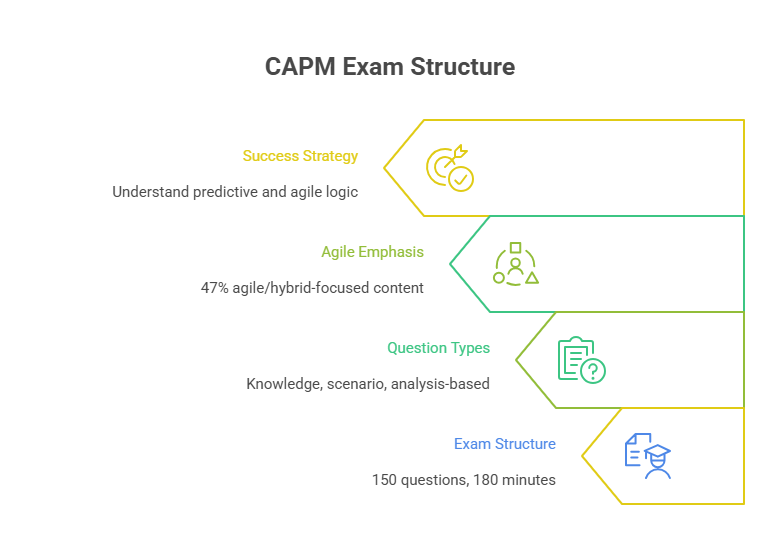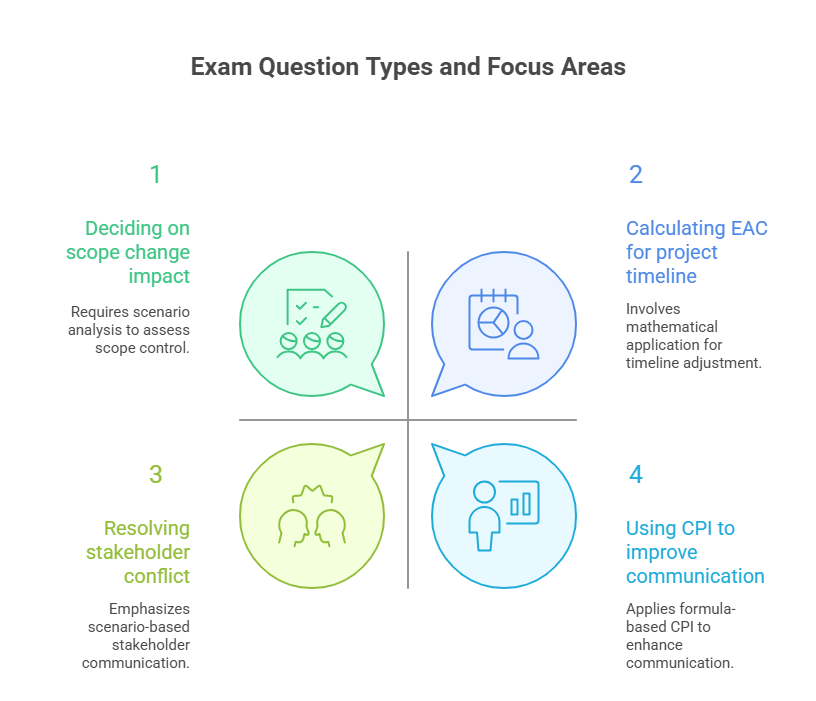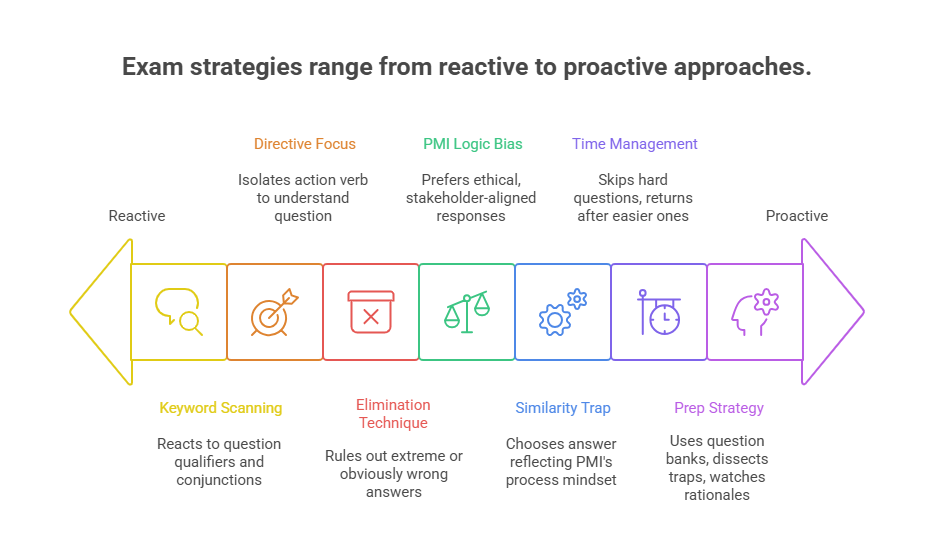Top 20 CAPM Exam Questions Clearly Answered (2025 Update)
Passing the CAPM exam in 2025 requires more than just memorizing the PMBOK® Guide—it demands deep familiarity with real question patterns, formats, and tricks. PMI’s latest updates have introduced greater emphasis on agile and hybrid frameworks, scenario-based logic, and critical thinking over rote learning. Candidates who review and understand actual question types score significantly higher on their first attempt.
This blog doesn’t waste time on the obvious. We’ve curated the 20 most relevant CAPM sample questions—drawn from 2025’s updated exam blueprint—and answered them with exam-level clarity. Every answer is structured to mirror how PMI wants you to think under pressure. Whether you're a student, transitioning professional, or junior PM, this is the CAPM question breakdown you need to boost your confidence and improve your pass probability.
How the CAPM Exam Is Structured in 2025
Understanding the 2025 CAPM exam structure gives you a massive edge—because it’s no longer just about definitions. PMI now tests your real-world decision-making ability across multiple domains using predictive, agile, and hybrid project management techniques. With 150 questions and a 3-hour timer, you’ll be tested on application, reasoning, and interpretation—not just facts.
Domains and Question Types
PMI’s updated Exam Content Outline (ECO) breaks the exam into three key domains:
Project Management Fundamentals and Core Concepts – ~36%
Predictive Plan-Based Methodologies – ~17%
Agile Frameworks/Methodologies – ~47%
Each question is mapped to a task within one of these domains. You’ll face three types of questions:
Knowledge-based questions testing your recall of terminology or concepts.
Application-based questions placing you in realistic project scenarios.
Analysis-style questions that require choosing the most effective course of action—not just a correct one.
More than 50% of the CAPM exam in 2025 is situational and reasoning-based, so surface-level prep isn’t enough.
Weightage of Predictive vs Agile Questions
A major shift in 2025 is the rise of agile. Nearly half of the exam is now focused on agile and hybrid approaches, reflecting current hiring trends across industries.
To break it down:
Traditional/predictive methods: Still crucial, especially for planning, scheduling, and risk topics.
Agile/hybrid methods: Heavily tested in areas like team collaboration, stakeholder engagement, and change adaptation.
This means ignoring agile principles is a fast track to failure. You’ll need to understand agile roles (Scrum Master, Product Owner), stand-up structures, and agile artifacts like product backlogs. PMI expects you to know when to apply agile, hybrid, or predictive—and how.
To prepare properly, you need to:
Practice with hybrid scenarios, where PMI mixes waterfall and agile elements.
Memorize key differences between agile and predictive approaches in scope, schedule, and change management.
Focus on mindset and behavior as much as process.
If you’re aiming to pass on your first attempt, mastering both predictive and agile content is non-negotiable.
Question Format Breakdown
The 2025 CAPM exam format has evolved to measure how well you apply project management concepts—not just whether you can define them. PMI focuses on situational comprehension, contextual judgment, and structured logic. Out of 150 questions, most are single-response, multiple-choice items, but their structure varies in purpose and difficulty. The real challenge is decoding the question’s intent under time pressure. Let’s break down the two major formats dominating the exam.
Scenario-Based Questions
These make up more than 50% of the CAPM exam and are PMI’s preferred method of evaluating decision-making under uncertainty. Each question presents a 2–5 line scenario, followed by four plausible answer options. What sets this format apart:
You must identify the most effective action, not just a correct one.
You’re often placed in real-world setups involving stakeholder conflict, scope creep, or scheduling constraints.
Traps are common—like multiple correct-sounding answers, or subtle wording shifts such as "best next step" vs "first thing you do."
PMI wants to see if you understand the flow of project logic—not just isolated facts. This means domain integration is key: you must think across cost, schedule, risk, and communication simultaneously.
Formula-Based and Conceptual Questions
Around 15–20% of the exam consists of questions that require math, structured logic, or conceptual depth. But these are rarely direct plug-and-play problems. PMI tends to bury variables inside a situational wrapper.
Examples include:
A question that asks about Schedule Performance Index (SPI), but in the context of a delayed deliverable.
An Earned Value Management (EVM) question that requires recognizing the right formula to apply—not just solving it.
Common formulas tested:
EVM: SPI, CPI, EAC, ETC
Schedule Logic: Float, critical path, forward/backward pass
Comms: n(n-1)/2 for communication channels
Estimating: Parametric vs bottom-up cost projections
PMI also integrates conceptual traps by offering answer choices that are similar-sounding tools. For instance, a question may test your ability to differentiate Monte Carlo simulation from expected monetary value (EMV)—both used in risk analysis but applied differently.
The key is recognizing why and when a tool is applied—not just what it is.
Top 20 Sample CAPM Questions with Answers
| # | Sample CAPM Exam Question (2025) | Answer & Rationale |
|---|---|---|
| Predictive Project Management Questions | ||
| 1 | What is the main output of the Define Activities process? | Activity List. This process identifies the specific tasks that must be performed to produce the project deliverables. |
| 2 | Which tool helps determine the earliest and latest a task can start? | Critical Path Method (CPM). It identifies the longest path and helps calculate float and schedule flexibility. |
| 3 | What does the Cost Performance Index (CPI) of 0.9 mean? | You're over budget. A CPI below 1.0 indicates that costs are higher than planned for the earned value. |
| 4 | In which process group is the Project Charter developed? | Initiating. The Develop Project Charter process formally authorizes the project and documents initial requirements. |
| 5 | What is rolling wave planning? | Progressive elaboration. Work is planned in detail for the near term and at a higher level for future work. |
| 6 | What is the primary purpose of a Work Breakdown Structure (WBS)? | Decompose project deliverables. The WBS organizes and defines the total scope of the project. |
| 7 | Which document lists all project risks and their analysis? | Risk Register. It contains identified risks, their characteristics, and response strategies. |
| 8 | Which type of dependency is legally or contractually required? | Mandatory Dependency. These are inherent in the nature of the work, such as concrete curing before framing. |
| 9 | What technique is used to compress schedule without changing scope? | Crashing. It adds resources to critical path activities to speed up delivery at increased cost. |
| 10 | Which document defines how scope will be validated and controlled? | Scope Management Plan. It outlines how scope will be defined, validated, and monitored throughout the project. |
| Agile / Hybrid Project Management Questions | ||
| 11 | What’s the purpose of a daily stand-up meeting? | Team synchronization. Stand-ups promote quick updates, issue resolution, and alignment of daily goals. |
| 12 | Who prioritizes the product backlog in a Scrum team? | Product Owner. They ensure the backlog reflects customer value and changing business needs. |
| 13 | Which artifact provides a shared understanding of “done”? | Definition of Done (DoD). It ensures completed work meets quality standards before delivery. |
| 14 | What is the purpose of a sprint retrospective? | Continuous improvement. The team reflects on the sprint and identifies areas to improve next time. |
| 15 | What is the ideal team size in agile environments? | 5–9 people. Small, cross-functional teams are more efficient and collaborative in agile settings. |
| 16 | What does velocity measure in agile projects? | Work delivered per sprint. Velocity tracks how many story points a team completes per iteration. |
| 17 | Which agile principle focuses on delivering value frequently? | “Deliver working software frequently.” It encourages incremental progress and rapid feedback loops. |
| 18 | What is a hybrid life cycle? | Blended approach. It combines predictive planning with agile execution for adaptive projects. |
| 19 | In agile, how is change typically handled? | Welcomed and embraced. Agile frameworks are built to accommodate change at any stage for customer value. |
| 20 | What is the Scrum Master’s primary role? | Servant leader. The Scrum Master removes impediments, facilitates events, and supports the team’s effectiveness. |
Common Mistakes Candidates Make
Scoring high on the CAPM exam requires more than studying hard—it demands avoiding the most common traps that derail first-time test takers. PMI designs questions to appear straightforward but embeds subtle logic shifts. Over 60% of failing candidates miss questions not because they lack knowledge, but because they misunderstand what is being asked. Here's how they slip up.
Misreading the Question
PMI questions often use qualifiers like “most appropriate,” “best next step,” or “least likely.” Candidates in a rush often miss these subtle cues. One misplaced glance can lead you to select a technically correct but contextually wrong answer.
For example, if a question says: “What should the project manager do first in response to a stakeholder concern?” and you choose “update the project plan,” you’ve likely failed to consider whether stakeholder communication should have come first.
To avoid this:
Underline action verbs during practice
Read all options before choosing
Always check if the question is asking for a first, next, or best action
Choosing the Most Familiar Term Instead of the Right One
PMI deliberately presents familiar terminology next to the correct choice to trigger instinctive errors. For example, you might see “risk mitigation” and instantly select it, even though “risk transference” was the right fit based on the scenario.
This happens when candidates:
Memorize definitions without understanding application
Don’t study overlapping tools like qualitative vs quantitative risk analysis
Pick options they’ve seen frequently, even if irrelevant
PMI rewards critical discernment, not comfort. A familiar word in the answers doesn’t mean it’s the correct one.
To prevent this:
Practice with questions that include similar-sounding distractors
Read each scenario slowly and match your answer to the actual objective—not your gut
Understand when and why you’d use each process tool—not just its definition
| Common Mistake | Explanation & How to Avoid It |
|---|---|
| Misreading the Question |
|
| Choosing the Most Familiar Term |
|
| Other Errors |
|
Pro Tips to Decode Trick Questions
PMI designs CAPM exam questions to measure clarity under pressure. Many candidates know the material but fail to spot how questions are meant to mislead. These tips will help you see through the trickery and decode PMI’s exact intent.
Keyword Scanning Techniques
One of the simplest ways to raise your score is to scan for command terms and qualifiers. PMI deliberately shifts meaning using subtle wording.
Look for:
"Best next step" vs "First action" — these mean different things
Words like "most appropriate," "least effective," "not recommended"
Tricky conjunctions like “but,” “however,” and “although” that reverse the meaning mid-sentence
Don’t start reading the answer options until you fully understand the question’s directive. If you're confused by what the question wants, your answer will always be off—even if you know the content.
Practicing this scanning habit makes you 30–40% faster over time.
Elimination Strategy Under Pressure
Most CAPM questions have at least two obviously wrong options, and your goal is to spot and remove them immediately. Then it’s a 50/50 guess—or better.
To use elimination effectively:
Discard answers that break PMI values or ethics
Watch for absolutes like “always,” “never,” “must” — PMI rarely uses these unless the concept is 100% universal
Cross out options that contradict the question’s logic or the project phase being referenced
When in doubt, ask: “Which of these violates scope, cost, or risk processes?” That alone knocks out at least one distractor.
Also: if two answers look correct, pick the one that is more process-oriented or stakeholder-aligned. PMI loves answers that show structured, planned actions—not emotional or impulsive responses.
How APMIC’s Course Helps You Master These Questions
Even the most determined candidates fail when they rely on free PDFs and outdated YouTube videos. To master the exact format, pressure, and logic PMI uses, you need training that mirrors the exam environment. That’s why the CAPM Certification Training from APMIC is engineered specifically to teach, simulate, and reinforce everything PMI tests—through advanced tools and guided logic.
Access to 1000+ Practice Questions
APMIC’s course includes over 1,000 exam-calibrated questions, modeled after the latest 2025 PMI ECO. Each item is filtered by domain, difficulty, and logic traps—ensuring that you get deep exposure to the exact type of questions you'll face.
Unlike generic mock tests, these questions include:
Scenario-heavy prompts that simulate real exam conditions
Distractor logic training, where you're taught how PMI sets traps
Topic-level analytics so you know where you’re weak, down to the task
Candidates who complete the full question bank score 30–50% higher than those using textbook-only strategies.
Video Walkthroughs with Rationales
Each question in the course comes with expert video walkthroughs—breaking down not just the right answer, but why the others are wrong. This is key to building PMI logic fluency. You’ll learn how to:
Spot high-risk wording like “not,” “least,” or “most effective”
Eliminate attractive but incorrect answers using contextual clues
Choose based on PMI’s structured mindset, not just project experience
These walkthroughs are created by certified PMPs and CAPMs who’ve passed the exam under real conditions and understand how PMI tests behavior—not just knowledge.
If you want a course that teaches you to think like PMI, not just memorize slides, this is it.
Frequently Asked Questions
-
PMI doesn’t disclose an official passing score for the CAPM exam, but it's estimated to be around 70% or higher based on performance domains. The exam uses psychometric analysis, meaning your score depends not just on the number of correct answers but also on the difficulty of each item. Some questions are weighted more heavily than others. You receive a proficiency rating—Above Target, Target, Below Target, or Needs Improvement—for each domain. To pass, you typically need a mix of Target and Above Target results across most sections. Consistency across all three domains is critical for passing.
-
Most candidates require 6–8 weeks of dedicated study if they’re starting from scratch. With prior PM experience, 4 weeks may be enough. Effective prep involves covering all three PMI domains—predictive, agile, and hybrid—with a focus on scenario-based practice questions. Study plans should include PMBOK® Guide review, mock exams, flashcards, and detailed question debriefs. Aim for 10–12 hours per week, spread across short sessions for retention. APMIC’s course offers a guided study schedule with diagnostic tests to track readiness and reduce wasted effort.
-
Yes. The CAPM certification is designed specifically for entry-level professionals. You don’t need formal project management work experience. To qualify, you must have either a high school diploma or global equivalent and complete 23 hours of formal project management education. APMIC’s CAPM prep course fulfills this education requirement. PMI has positioned CAPM as the ideal certification for recent graduates, interns, and junior professionals seeking to enter the project management space without prerequisites like the PMP.
-
You’ll encounter formula-based questions, primarily from the domains of Earned Value Management (EVM), critical path calculations, and basic estimating techniques. Key formulas include:
CPI = EV / AC,
SPI = EV / PV,
EAC = BAC / CPI,
and float calculations for schedule analysis.
Math is rarely presented as direct calculation problems. Instead, PMI embeds formulas within scenarios—so you must know when to apply them. Understanding formula logic is more important than solving algebraically. APMIC’s course includes step-by-step formula breakdowns with video explanations.
-
Yes—and no. The 2025 CAPM exam includes a heavier emphasis on agile and hybrid methodologies, now accounting for 47% of total exam content. While this adds complexity, it reflects the modern realities of project environments. Candidates who study only predictive methods will struggle. However, agile frameworks are often more intuitive for newcomers because they focus on collaboration, feedback loops, and adaptability. If you use a structured course—like APMIC’s—you’ll be walked through the agile mindset, ceremonies, roles (Scrum Master, Product Owner), and artifacts. The difficulty increases only if you're underprepared in these areas.
-
You can take the CAPM exam up to 3 times within your 1-year eligibility window after your application is approved. If you don’t pass after three attempts, you’ll need to wait one year before reapplying and paying the exam fee again. PMI allows retakes at a reduced cost, but it’s important to use each attempt strategically. After each failure, review your domain performance ratings, adjust your study plan, and focus on weak areas. APMIC’s analytics dashboard helps identify question categories where you’re scoring below target, improving your chances on your next try.
-
Yes. PMI allows you to reschedule or cancel your CAPM exam up to 48 hours before your scheduled time through Pearson VUE. If you reschedule within 30 days of your exam date, a $70 fee applies. No-shows or cancellations within 48 hours forfeit your entire exam fee. Emergencies may be appealed, but documentation is required. We recommend scheduling your exam only once you consistently score 75–80% or higher on practice tests. APMIC includes exam readiness trackers to help you know exactly when you're ready to book—saving money and maximizing pass probability.
Our Verdict
To pass the CAPM exam on your first attempt in 2025, mastering PMI’s question style is non-negotiable. It’s no longer about remembering process charts—it’s about interpreting situational triggers, applying logic under pressure, and knowing why one answer works better than another.
The fastest path to readiness? Practice the exact types of questions you'll face—scenario-based, formula-driven, and agile-heavy. Use a question bank built on PMI's 2025 blueprint. Study with video rationales, performance analytics, and agile/predictive integration.
With APMIC’s CAPM Certification Training, you gain access to everything PMI wants you to master—before exam day.




